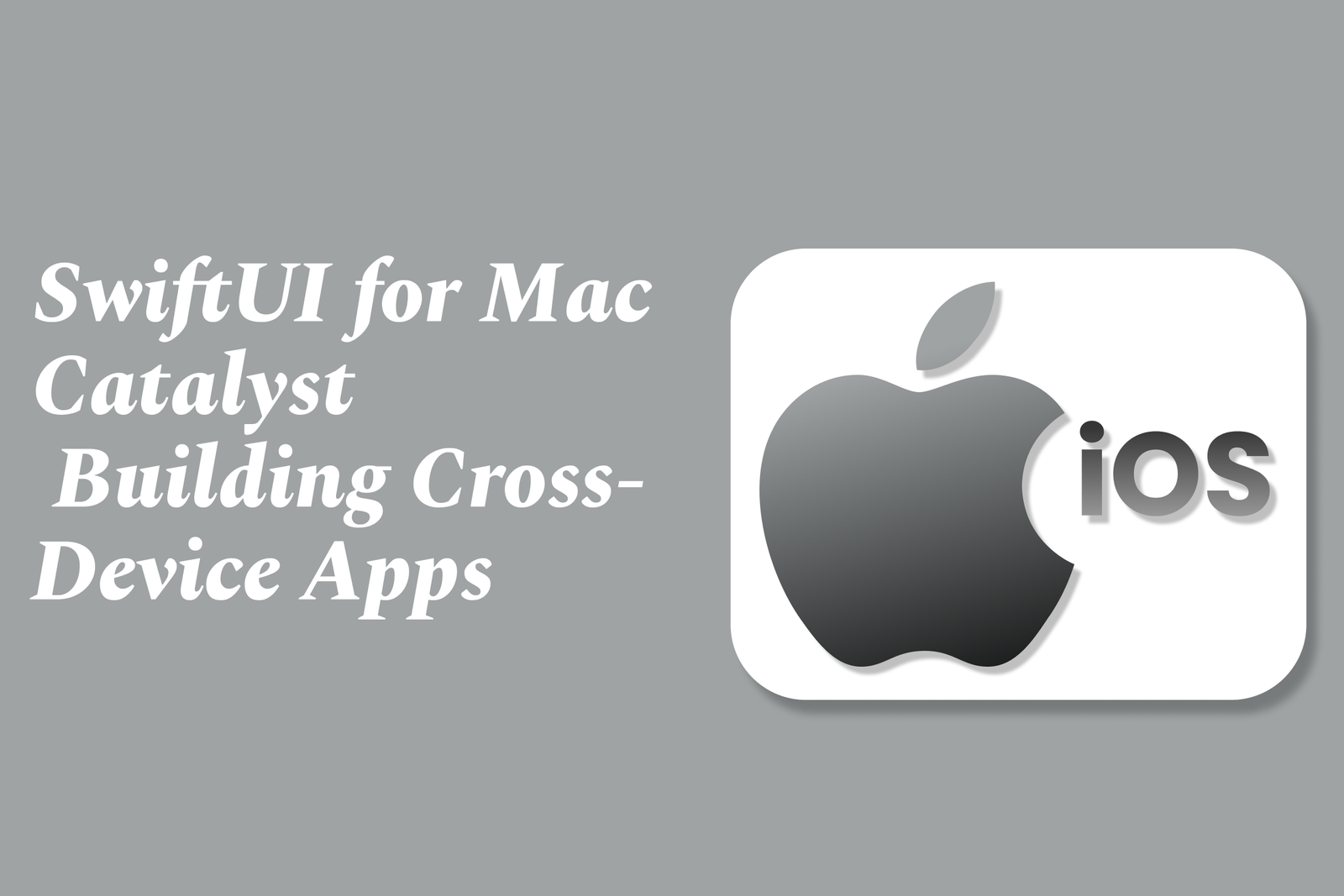SwiftUI for Mac Catalyst: Building cross-device apps
SwiftUI for Mac Catalyst enables developers to build seamless, cross-device apps by using a single SwiftUI codebase that runs on iOS, iPadOS, and macOS. It simplifies UI design, boosts efficiency, and offers native performance across Apple platforms.
SwiftUI for Mac Catalyst: Building Cross Device Apps
1 ) The Shift Towards SwiftUI and Catalyst for macOS Development
Traditional macOS development using AppKit is becoming less prominent, with many developers now focusing on SwiftUI for its modern, cross platform capabilities.
SwiftUI offers a unified approach to building user interfaces that can work seamlessly across iOS, iPadOS, and macOS, often leveraged via Mac Catalyst to port iPad apps to Mac.
Although AppKit remains relevant for highly specialized or performance critical macOS software, SwiftUI and Catalyst represent the future direction encouraged by Apple.
2 ) Advantages of SwiftUI and Catalyst for Cross Device Apps
Cross platform efficiency: Developers can write less platform specific code and maintain a single codebase for multiple Apple devices.
Unified development experience: SwiftUI’s declarative syntax simplifies UI design and state management and allows easier sharing of logic and interfaces.
Apple ecosystem integration: Apps built with SwiftUI and Catalyst naturally leverage native Apple APIs, offering better performance and look and feel fidelity compared to cross platform frameworks like Electron.
3 ) Current Limitations and Challenges
SwiftUI for macOS has limitations in window and lifecycle management, lacking fine grained control over individual windows and some APIs like scenePhase for observing window state.
Some macOS specific APIs and functionalities, especially for non trivial window management or system level operations, are unavailable or harder to implement via Catalyst.
SwiftUI and Catalyst might limit developers if their app requires deep OS integration or highly customized UI behavior exclusive to macOS.
4 ) Performance and Tooling Considerations
SwiftUI apps built with Catalyst compile to native machine code, offering performance comparable or superior to Objective C or UIKit apps.
Despite SwiftUI’s growing maturity, certain advanced use cases or large applications may still face hurdles due to framework instability or feature gaps.
Alternative frameworks like RemObjects Elements currently do not support SwiftUI directly, emphasizing the dominant Apple Swift toolchain for UI development on Apple platforms.
5 ) Community and Industry Perspectives
Developers note a scarcity of macOS specific Swift learning resources, as most tutorials target iOS and general Swift programming.
There is a divided view on whether to focus on native macOS apps or adopt cross platform web/JS based solutions; native apps remain preferred for performance demanding, OS integrated applications.
Many recommend starting cross device Apple app development with SwiftUI and Catalyst for broader reach, switching to AppKit only when advanced macOS features are necessary.
6 ) Best Practices for Building Cross Device Apps with SwiftUI & Catalyst
Begin with SwiftUI for UI code shared across iOS, iPadOS, and macOS, using conditional compilation (#if os(macOS)) to handle platform specific tweaks.
Use Mac Catalyst to port iPad apps to macOS when targeting a broader device base without completely separate UI codebases.
Supplement SwiftUI with AppKit APIs via bridging if advanced macOS only features or window management are needed.
Stay updated with SwiftUI releases, as Apple continuously improves its macOS capabilities and ecosystem support.
Summary:
SwiftUI combined with Mac Catalyst presents a powerful framework for building modern, cross device Apple apps with streamlined development and native performance. While some macOS specific challenges remain, this approach reflects the evolving best practice endorsed by Apple and growing developer adoption, especially for those aiming for code reuse between iOS and macOS platforms.
https://justacademy.in/news-detail/flutter-vs-ionic-2025-performance
https://justacademy.in/news-detail/react-native?s-upcoming-features:-what-to-watch-for
https://justacademy.in/news-detail/android-input-method-editors-updates
https://justacademy.in/news-detail/ios-19-dark-mode-improvements-and-design-tips
https://justacademy.in/news-detail/react-native-expo-sdk-roadmap-for-2025
Related Posts
In 2025, top Angular libraries offer modern, feature-rich components and tools for building dynamic web apps. From powerful data grids to low-code platforms like UI Bakery, these libraries enhance development speed, UI design, and scalability, making them essential for Angular developers.
Migrating from AngularJS to Angular 17 involves gradually upgrading your app by running both frameworks together using tools like ngUpgrade, rewriting components in TypeScript, and adopting Angular’s modern architecture to enhance performance, maintainability, and long-term support.
Angular state management tools help organize and handle app data efficiently, improving scalability and maintainability. Popular options include NgRx for robust, RxJS-based patterns, and newer Signal Store solutions that offer simpler, reactive approaches integrated tightly with Angular’s latest features.
RxJS in Angular empowers developers to manage asynchronous data streams with powerful operators like `forkJoin`, `combineLatest`, and `zip`. Mastering these key operators in 2025 is essential for building efficient, reactive applications that handle complex event sequences seamlessly.
Angular performance optimization in 2025 focuses on improving app speed and responsiveness by using techniques like OnPush change detection, lazy loading, efficient data caching, and AOT compilation. These practices reduce load times, enhance user experience, and ensure scalable, fast Angular applications.
In 2025, Angular remains preferred for large-scale, enterprise apps with its robust, all-in-one framework, while Vue attracts developers seeking simplicity and fast development for smaller projects. Both frameworks excel, with choice driven by project needs and team expertise.
Angular Signals are a new reactive primitive in Angular 16 that enable fine-grained, efficient change detection by automatically tracking dependencies and updating only affected parts of the UI. They simplify state management and boost app performance, revolutionizing Angular's reactivity model.
Angular interview questions to prepare in 2025 focus on core concepts like components, directives, data binding, routing, and dependency injection, along with TypeScript mastery and latest Angular features to ensure strong practical knowledge for building scalable, efficient web applications.
AngularJS reached its official end of support in January 2022, meaning no further updates or security patches. To ensure app security and performance, developers should consider migrating to modern Angular versions or seek third-party long-term support options if immediate migration isn’t possible.
The Angular Roadmap 2025 highlights upcoming features focused on improving developer experience and performance, including zoneless Angular, Signals integration, enhanced Forms, async data handling, improved HMR, and expanded Angular Material/CDK enhancements, driving modern, efficient web app development.










